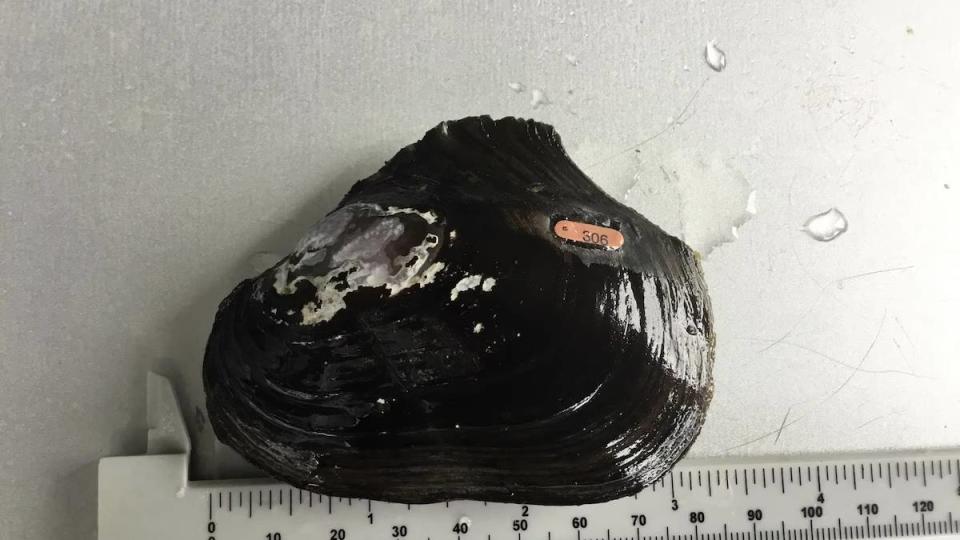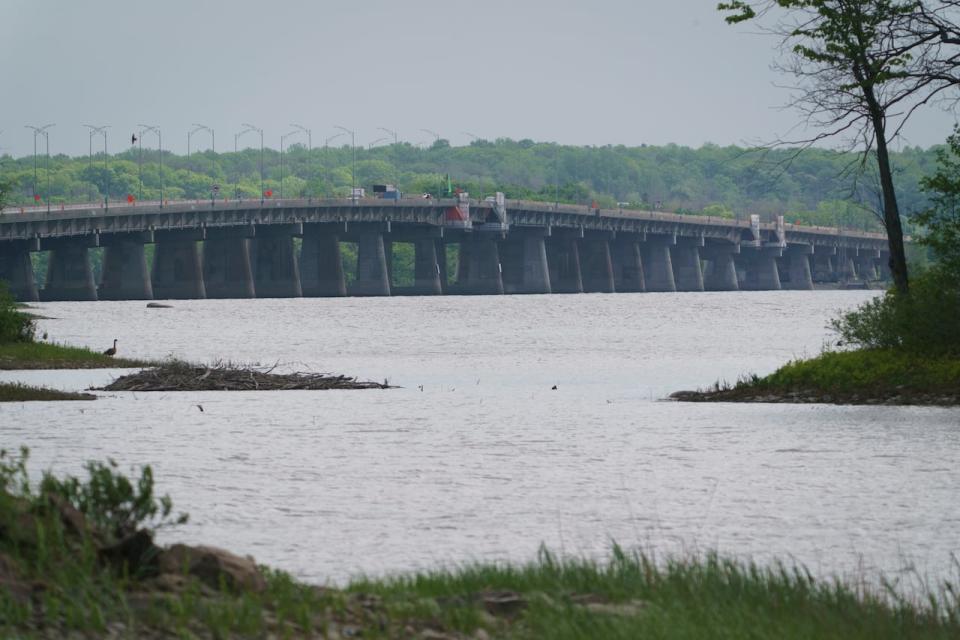Teams of biologists have relocated more than 33,000 freshwater mussels from the construction site of the new Île-aux-Tourtes Bridge, which will connect Montreal’s West Island to Vaudreuil-Dorion.
A relocation operation of this scale is unprecedented for a Quebec construction site.
Construction of the bridge began in late 2023, north of the current bridge. But before that work started, biologists were cataloguing the mussel population in the area.
Studies conducted in 2019 and 2020 confirmed the presence of freshwater mussels, with three species potentially designated as threatened or vulnerable: the elliptio, the leptodea and the round pigtoe.
These mussels, generally found at the bottom of waterways like the Lake of Two Mountains, were at risk of being crushed or disturbed by the construction of temporary docks.
“We knew there would be environmental impacts in the lake, particularly due to the piers requiring stones to be placed on the lakebed,” said Sarah Chabot, a biologist at the Ministry of Transport who has been overseeing the environmental assessment.
“These are very important organisms because they filter water to feed.”

The round pigtoe is one of the relocated mussel species. It is a freshwater mussel species that may be designated as threatened or vulnerable. (Submitted by Santec)
McGill University’s Anthony Ricciardi said freshwater mussels are the most endangered group of animals in North America.
“They are long-lived, slow-growing species that are very sensitive to habitat alteration,” said Ricciardi, professor of invasion ecology and aquatic ecosystems.
“Most of the species in the Ottawa River can live for over 30 years and take several years to mature. These are among the traits that render them susceptible to extinction.”
Losing tens of thousands of individual mussels to the bridge construction project would have been devastating as it would take many decades for their populations to recover, he said.
“The adults cannot move very far on their own,” Ricciardi said. “Relocating them may be the only conservation option.”
Moved by hand and slotted spoon
Using their siphons, mussels draw in water and retain certain particles for nourishment. Others are expelled and settle at the bottom, where they support other organisms, Chabot said.
The water filtered by the mussels allows light to penetrate better, providing clarity to underwater plants. These plants serve as both shelter for fish and food for animals.


The old Île-aux-Tourtes Bridge will be replaced by a new bridge just north of its current location. (Ivanoh Demers/Radio-Canada)
These freshwater mussels, about 10 centimetres in size but sometimes exceeding 15 centimetres, can live up to 100 years, depending on the species.
While they might sound like marine mussels that are popular to eat, biologists advise against eating these freshwater molluscs as they sometimes contain toxins, pollutants and heavy metals.
In 2023, a total of 33,735 live mussels were relocated from the construction site in Lake of Two Mountains.
That’s more than four times the size of the mussel relocation operation at the site of the new Île-d’Orléans Bridge near Quebec City, where about 8,000 mussels were moved.
“I had never seen anything of this scale,” said Chabot.
Whether diving or snorkelling, swimmers collected the mussels by hand, sometimes using a slotted spoon that allows substrate to pass through, or using a bathyscope, a device for probing the bottom of the water.
To ensure the mussels remained in the water throughout the operation, they were transported from one location to another in a net pulled behind a boat, when the lake’s depth allowed.
Carefully chosen new location
At their new destination, the mussels were released into two areas of the lake north of the new bridge and upstream of the construction site, so that the water would not carry debris or substances from the work. Other mussel populations had already been observed there.
Biologists ensured that the areas had the capacity to accommodate more mussels to allow for species reproduction. The substrate also needed to be sufficiently soft, as mussels tend to move according to their needs.
“That’s why the site had to be far enough from the work area. Since mussels are mobile, we didn’t want to go through all this effort only to find out they had come back,” said Chabot.
Of the 300 freshwater mussel species recorded in North America, about 20 are found in Quebec.


A team of divers and snorkellers carried out the operation to move the mussels. (Submitted by Santec)
Since 2000, inventories have been conducted annually in the province to better target the distribution of freshwater mussels and refine knowledge about them.
Unsurprisingly, habitat degradation and destruction top the list of threats to the most precarious species. The presence of invasive exotic species, such as the zebra mussel, also contributes to their decline. These organisms attach to the shells of mussels and obstruct their valves.
During the operation in Lake of Two Mountains, biologists spotted zebra mussels on some mussels, but the colonization rate was low, according to a report by Stantec, a company hired by the ministry to carry out the relocation. In all cases, the zebra mussels were removed and destroyed before the mussels were returned to the water.
More animals to relocate, including falcons
In line with commitments made at COP15 on biodiversity in Montreal, the Quebec government has pledged to protect 30 per cent of the province’s territory by 2030.
They also plan to designate new species as threatened or vulnerable and address the issue of invasive species.
Renowned for their most unusual reproductive method, freshwater mussels transform part of their mantle into a growth resembling a small fish. Deceived, fish spawn and unknowingly carry the mussel embryos that attach to their gills or fins for several months, after which they detach and fall to the bottom of the water.
The mussels from Lake of Two Mountains will be observed until 2026 to allow the ministry to ensure their survival and make adjustments if necessary.
Like mussels, species of fish, turtles, and birds may have their habitat disrupted by the construction project.
This is the case for the peregrine falcon, whose nest, currently attached to the existing Île-aux-Tourtes Bridge, will be relocated to the future structure.
Box turtles, which are very site-faithful, are excluded from the relocation effort. It’s difficult to encourage them to move elsewhere, said Chabot. However, barriers have been installed to prevent them from accessing the construction site.

